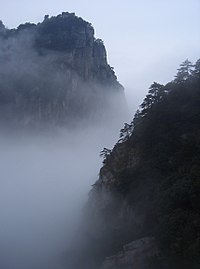Pinus hwangshanensis
| Huangshan pine | |
|---|---|

| |
| Huangshan pines on the Huangshan Mountains, Anhui | |
| Scientific classification | |
| Kingdom: | Plantae |
| Clade: | Tracheophytes |
| Clade: | Gymnospermae |
| Division: | Pinophyta |
| Class: | Pinopsida |
| Order: | Pinales |
| Family: | Pinaceae |
| Genus: | Pinus |
| Subgenus: | P. subg. Pinus |
| Section: | P. sect. Pinus |
| Subsection: | P. subsect. Pinus |
| Species: | P. hwangshanensis
|
| Binomial name | |
| Pinus hwangshanensis | |
| Synonyms[2] | |
| |
Pinus hwangshanensis,[1] or Huangshan pine, is a pine endemic to the mountains of eastern China; it is named after the Huangshan Mountains in Anhui, from where it was first described.
Description
Pinus hwangshanensis is an evergreen tree reaching 15–25 metres (49–82 feet) in height, with a very broad, flat-topped crown of long, level branches. The bark is thick, grayish, and scaly plated. The leaves are needle-like, dark green, 2 per fascicle, 5–8 centimetres (2–3+1⁄4 inches) long and 0.8–1 millimetre (1⁄32–3⁄64 in) wide, the persistent fascicle sheath 1 cm (1⁄2 in) long. The cones are broad squat ovoid, 4–6.5 cm (1+1⁄2–2+1⁄2 in) long, yellow-brown, opening when mature in late winter to 5–7 cm broad. The seeds are winged, 5–6 mm (3⁄16–1⁄4 in) long with a 1.5–2.5 cm wing. Pollination occurs in mid-spring, with the cones maturing 18–20 months after.
It is closely related to Japanese black pine (P. thunbergii), differing from it in the slenderer leaves, brown (not white) buds and broader cones.[citation needed]
Distribution and habitat
Huangshan pines are endemic to the mountains of eastern China, in the provinces of Anhui, Fujian, Guizhou, Hubei, Hunan, Jiangxi, and Zhejiang.
They typically grow at moderate to high altitudes on steep, rocky crags, and are a major vegetation component in the landscapes of eastern China. Many specimens are venerated for their unique rugged shapes and are frequently portrayed in traditional Chinese paintings.[citation needed]
-
Huangshan pines on Mount Lushan, Jiangxi
References
- ^ a b Farjon, A. (2013). "Pinus hwangshanensis". IUCN Red List of Threatened Species. 2013: e.T42370A2975804. doi:10.2305/IUCN.UK.2013-1.RLTS.T42370A2975804.en. Retrieved 11 November 2021.
- ^ "The Plant List: A Working List of All Plant Species".



